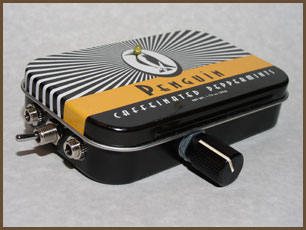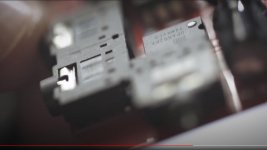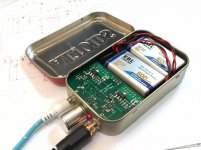How would one mod the classic CMoy portable diy head amp project to output, say, 1-w. Say, for high-Z 'phones or otherwise non-sensitive cans?

It seems a seller on eBay has done this.
audeep CMoy model I - 1 Watt portable headphone amplifier US POWER SUPPLY BUNDLE | eBay
But how? Especially in a portable chassis?

It seems a seller on eBay has done this.
audeep CMoy model I - 1 Watt portable headphone amplifier US POWER SUPPLY BUNDLE | eBay
But how? Especially in a portable chassis?
You don't need it
1W of power into headphones with 85 dB @ 1 mW (so relatively inefficient) is still 80+30=115 dB SPL. At that sound pressure level, hearing impairment begins after about 30 seconds of exposure.
One watt of audio power, even making allowances for musical crest factors and inefficient headphones, is way too much power for a safe headphone amplifier. My designs clip at 150 mW, and even that scares me when I think about how loud it can go.
-JS
1W of power into headphones with 85 dB @ 1 mW (so relatively inefficient) is still 80+30=115 dB SPL. At that sound pressure level, hearing impairment begins after about 30 seconds of exposure.
One watt of audio power, even making allowances for musical crest factors and inefficient headphones, is way too much power for a safe headphone amplifier. My designs clip at 150 mW, and even that scares me when I think about how loud it can go.
-JS
For paying work, I built an amp to make 8Vrms behind 55 Ohms (power transistor finals). That's "only" a quarter-Watt in 32-100 Ohms. Often working on-stage around medium orchestras and jazz ensembles, I may have clipped it once or twice a year with raw mike signal. For pay! I can't imagine wanting a Whole Watt for self-pleasure.
It's certainly not a technical problem.
It's certainly not a technical problem.
High power for certain 'phones and IEMs
DontHertzMe: Good detective work on the OPA

Believe it or not, I created this thread not for full-sized headphones (certain models need even MORE pwr than 1-watt), but for certain IEMs (a new planar magnetic type that do seem to need gobs of pwr).
I highly recommend watching these two videos:
Tin P2 _(Z Reviews)_ oh ma god - YouTube
Beyerdynamic DT880 600Ω _(Z Reviews)_ ⚡ G. O. D. ⚡ - YouTube
DontHertzMe: Good detective work on the OPA
Yeah .... I used to think along these lines. And then Nature kicked me in the HEAD1W of power into headphones with 85 dB @ 1 mW (so relatively inefficient) is still 80+30=115 dB SPL. At that sound pressure level, hearing impairment begins after about 30 seconds of exposure.
One watt of audio power, even making allowances for musical crest factors and inefficient headphones, is way too much power for a safe headphone amplifier. My designs clip at 150 mW, and even that scares me when I think about how loud it can go.
-JS
Believe it or not, I created this thread not for full-sized headphones (certain models need even MORE pwr than 1-watt), but for certain IEMs (a new planar magnetic type that do seem to need gobs of pwr).
I highly recommend watching these two videos:
Tin P2 _(Z Reviews)_ oh ma god - YouTube
Beyerdynamic DT880 600Ω _(Z Reviews)_ ⚡ G. O. D. ⚡ - YouTube
Says on the website of the Tin P2: Nominal Impedance 32 Ohms, max. power 10mW. Surely this can't be the IEM that needs "gobs of pwr"?! Because that's sounds like an easy job even for a single OPA1688. There are some CMOY designs here with OPA1688.
If you want to drive the DT880 600 Ohm to it's specified power limit of 100mW, the limitation is posed by the power rails: You would need 7-ish Volts RMS, so around 20Vpp (which is obviously more than two 9V batteries can provide).
If you want to drive the DT880 600 Ohm to it's specified power limit of 100mW, the limitation is posed by the power rails: You would need 7-ish Volts RMS, so around 20Vpp (which is obviously more than two 9V batteries can provide).
Decibel power is logaritmic ...
This should not come as strange surprise . Many very low-power tube amps can drive various loudspeaker designs to high levels. And there are plenty of examples of super high-power amps (Crown, etc) being used for puny bookshelves (LS3 5a's).
In the case of the high-power amp for 'phones ... it may be as simple as very clean, low distortion signalling , because driving the wimpy headphones transducer is so effortless.
I have heard the dt-880's thru a speaker amp .... and using caution with that vol. control knob ... wow! These cans transform into something special. Not sure how Beyer designers intended its use ... maybe their laboratory (bench-top) amp was a speaker amp?
Realize each of the max specs you cite are not to be INTENTIONALLY exceeded with the use of high-power amps--that would destroy the 'phones. It's that up to that max limit, the topology driving the phones is of the "high" power variety.Says on the website of the Tin P2: Nominal Impedance 32 Ohms, max. power 10mW. Surely this can't be the IEM that needs "gobs of pwr"?! Because that's sounds like an easy job even for a single OPA1688. There are some CMOY designs here with OPA1688.
If you want to drive the DT880 600 Ohm to it's specified power limit of 100mW, the limitation is posed by the power rails: You would need 7-ish Volts RMS, so around 20Vpp (which is obviously more than two 9V batteries can provide).
This should not come as strange surprise . Many very low-power tube amps can drive various loudspeaker designs to high levels. And there are plenty of examples of super high-power amps (Crown, etc) being used for puny bookshelves (LS3 5a's).
In the case of the high-power amp for 'phones ... it may be as simple as very clean, low distortion signalling , because driving the wimpy headphones transducer is so effortless.
I have heard the dt-880's thru a speaker amp .... and using caution with that vol. control knob ... wow! These cans transform into something special. Not sure how Beyer designers intended its use ... maybe their laboratory (bench-top) amp was a speaker amp?
These limits are not to be exceeded under any circumstances, regardless of what amplifier is used.
Make up your mind! You can't drive the DT880 600 Ohm to their power limit from two 9V batteries, because it needs about 20Vpp for that. The Tin P2 on the other hand doesn't even need 2Vpp to reach it's specified power limit. In other words the Tin P2 wouldn't need any gain, the DT880 closer to 20dB of gain, assuming a single ended line level source.
I also suggest that you view Zeos as who he is - an entertainment oriented "audiophile influencer".
Make up your mind! You can't drive the DT880 600 Ohm to their power limit from two 9V batteries, because it needs about 20Vpp for that. The Tin P2 on the other hand doesn't even need 2Vpp to reach it's specified power limit. In other words the Tin P2 wouldn't need any gain, the DT880 closer to 20dB of gain, assuming a single ended line level source.
I also suggest that you view Zeos as who he is - an entertainment oriented "audiophile influencer".
kn0ppers ....
kn0ppers .... your reply is confusing!
Search my posts ... did I ever suggest that DT880 600 Ohm be powered from the CMoy? Well, did I?!!!!!!!!!!!


In any case, there are plenty of commercial examples of high-power headphone amps. The $260 portable Xduoo XD-05+ will output 1000mW into 32-ohm.
kn0ppers .... your reply is confusing!
Make up your mind! You can't drive the DT880 600 Ohm to their power limit from two 9V batteries, because it needs about 20Vpp for that.
Search my posts ... did I ever suggest that DT880 600 Ohm be powered from the CMoy? Well, did I?!!!!!!!!!!!

In any case, there are plenty of commercial examples of high-power headphone amps. The $260 portable Xduoo XD-05+ will output 1000mW into 32-ohm.
It seems that many of the commercial headphone amps coming out nowadays -- Chinese brands like SMSL, etc, common on Amazon, Ali and eBay -- do offer high-power output.
I was just looking at my SMSL SP200 ... check out its specs on Amazon if you're curious.
Anyway, for my dt880-280 (280 ohm version), I found that these cans come into their own in the HIGH GAIN mode. Which, in the SP200, tops out around 400mW for 300-ohm Z.
I was just looking at my SMSL SP200 ... check out its specs on Amazon if you're curious.
Anyway, for my dt880-280 (280 ohm version), I found that these cans come into their own in the HIGH GAIN mode. Which, in the SP200, tops out around 400mW for 300-ohm Z.
kn0ppers ....
Now if anyone has any theories as to why high-power amplification is ideal for certain drivers .... well, I'm all ears
kn0ppers .... I think folks like you still don't either GET it or ACCEPT the possibility that higher power amplification at any volume level is ideal for certain transducers.As you were talking about a CMOY for high Z phones in your opening post and considering the examples you gave, I think my assumptions weren't too far-fetched.
Whatever you end up doing, please always keep in mind that you can't replace your ears like a socketed OpAmp...
Now if anyone has any theories as to why high-power amplification is ideal for certain drivers .... well, I'm all ears
NO, you are not.
There's simply y no need to need high power capability when the headset can't use it - see posts above - this is simply one of those race-to-the-bottom BS shows where because some tit realised 12v rails potentially facilitate a whole watt into some kind of nominal headphone, it becomes the new normal-expectation - for reasons that are baseless on performance grounds. 100mW into anything resembling a good design will threaten your hearing.
Same way many people think they 'need' 500W + /ch for 'headroom' in domestic stereo, and so compromise what they actually get at the levels they use - when for most purposes, a nice, simple, really clean 10-50w at most will do what they actually use, and want.
Concentrate on quality, rather than quantity.
ETA - on that thought - you could just buy a Chord Mojo - 10 hr battery life, 0.5A per channel capable into low impedances , fab with IEMs.
There's simply y no need to need high power capability when the headset can't use it - see posts above - this is simply one of those race-to-the-bottom BS shows where because some tit realised 12v rails potentially facilitate a whole watt into some kind of nominal headphone, it becomes the new normal-expectation - for reasons that are baseless on performance grounds. 100mW into anything resembling a good design will threaten your hearing.
Same way many people think they 'need' 500W + /ch for 'headroom' in domestic stereo, and so compromise what they actually get at the levels they use - when for most purposes, a nice, simple, really clean 10-50w at most will do what they actually use, and want.
Concentrate on quality, rather than quantity.
ETA - on that thought - you could just buy a Chord Mojo - 10 hr battery life, 0.5A per channel capable into low impedances , fab with IEMs.
Think of it this way .... tube amps and NOS dacs. They measure "poorly" but have subjective characteristics that some like.
The Senn. hd600 is legendarily know for coming into its own after being driven with SE tube amps. I know ... I've got one in this config ... and its the best headphone listening in the house.
As far as my listening habits ... I like low to medium volume listening. AKG-701 are good low-volume cans that fit the bill. But I don't have a good (scientific) explanation for why I prefer high power for certain Beyer's, planars or that IEM.
I don't think the aforementioned "trend" in high-power (GAIN) in COMMERCIAL amps (smsl, xudoo, etc) is "baseless". Many modern cans -- especially the plethora of planars -- really need that much pwr.
The Senn. hd600 is legendarily know for coming into its own after being driven with SE tube amps. I know ... I've got one in this config ... and its the best headphone listening in the house.
As far as my listening habits ... I like low to medium volume listening. AKG-701 are good low-volume cans that fit the bill. But I don't have a good (scientific) explanation for why I prefer high power for certain Beyer's, planars or that IEM.
I don't think the aforementioned "trend" in high-power (GAIN) in COMMERCIAL amps (smsl, xudoo, etc) is "baseless". Many modern cans -- especially the plethora of planars -- really need that much pwr.
You can use DCDC step up for more voltage. But 500mW is more than enough unless using HE-4 82dB planars which need 3W. Really a speaker amp.
OPA6120A2 is capable of 700mA +/-15v and as low as 16ohm load, low distortion, and sounds great.
https://www.ti.com/lit/ds/symlink/t...37392&ref_url=https%3A%2F%2Fwww.google.com%2F
OPA6120A2 is capable of 700mA +/-15v and as low as 16ohm load, low distortion, and sounds great.
https://www.ti.com/lit/ds/symlink/t...37392&ref_url=https%3A%2F%2Fwww.google.com%2F
Last edited:
It may very well be that opamps being fed higher power (V_cc) (which has the SECONDARY effect of high output power), is the primary reason for increased fidelity of certain headphone transducers.
That is, the opamp or related circuit behaves better at higher V_cc.
None of the people -- including myself-- who have reported increased fidelity have said anything about loud listening preferences. If anything, it is the opposite: quiet- and moderate-volume listening benefit most with "higher power".
That is, the opamp or related circuit behaves better at higher V_cc.
None of the people -- including myself-- who have reported increased fidelity have said anything about loud listening preferences. If anything, it is the opposite: quiet- and moderate-volume listening benefit most with "higher power".
Oh - I get that; but it's not clear as your requirement in your early post - so my apologies if my previous reply seemed a bit intemperate!
It's always instructive to look at performance curves for opamps at min vs max rated supply voltages; there can be differences; and for any discrete amplifier, running very close to the rails can drop performance for a bunch of reasons - secondary effects in the transistors nearing saturation, the simple current sources 'softening' and so on.
However I think your main problem is simply going to be power density in the power source: 10mA draw at say +/-12v is very nearly five times the power dissipation when compared with some small device running off a single 5v rail. But a 5v usb powerbank and something like Jan Didden's 'silent switcher' psu board could be a good start there, to give you up to +/-15v supply rails - from a single 'battery''source that can be charged off any available USB output.
It's always instructive to look at performance curves for opamps at min vs max rated supply voltages; there can be differences; and for any discrete amplifier, running very close to the rails can drop performance for a bunch of reasons - secondary effects in the transistors nearing saturation, the simple current sources 'softening' and so on.
However I think your main problem is simply going to be power density in the power source: 10mA draw at say +/-12v is very nearly five times the power dissipation when compared with some small device running off a single 5v rail. But a 5v usb powerbank and something like Jan Didden's 'silent switcher' psu board could be a good start there, to give you up to +/-15v supply rails - from a single 'battery''source that can be charged off any available USB output.
Last edited:
1z2a3y,
If you like the sound of SE tube amps, you might like the sound of my pocket Class A headphone amp. Fits in mint tin and uses two 9v batteries. Its SE Class A so burns through batteries in 3-4hrs. So use rechargeables. It’s not high power but drives high impedance headphones very well. It’s one of my favorite amps for 250ohm DT880. There are people who made versions of it with freely available Gerbers - look in the thread. It’s very simple - just 2 transistors. If you want to build one, send me a PM and I’ll give you a PCB for cost of shipping.
If you like the sound of SE tube amps, you might like the sound of my pocket Class A headphone amp. Fits in mint tin and uses two 9v batteries. Its SE Class A so burns through batteries in 3-4hrs. So use rechargeables. It’s not high power but drives high impedance headphones very well. It’s one of my favorite amps for 250ohm DT880. There are people who made versions of it with freely available Gerbers - look in the thread. It’s very simple - just 2 transistors. If you want to build one, send me a PM and I’ll give you a PCB for cost of shipping.
Attachments
Last edited:
- Status
- This old topic is closed. If you want to reopen this topic, contact a moderator using the "Report Post" button.
- Home
- Amplifiers
- Headphone Systems
- High power output PORTABLE headphone amp (1-watt ot more)

